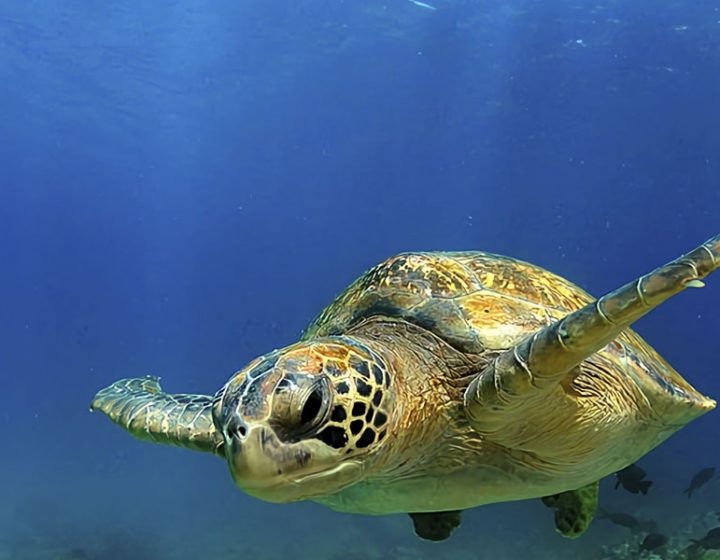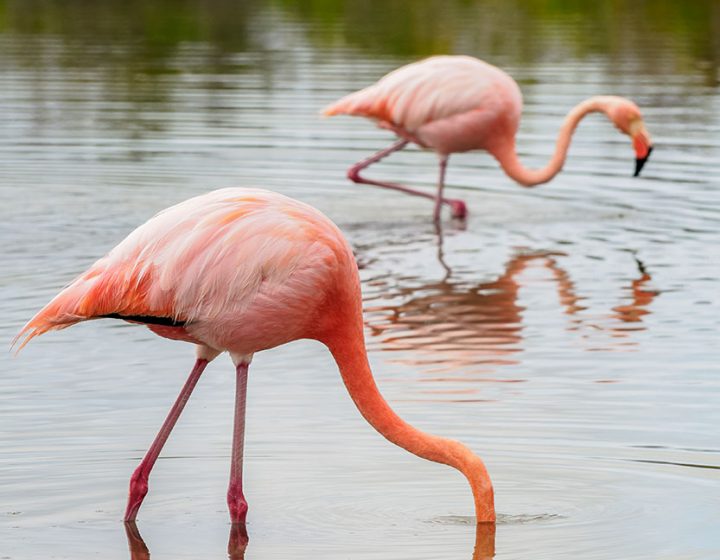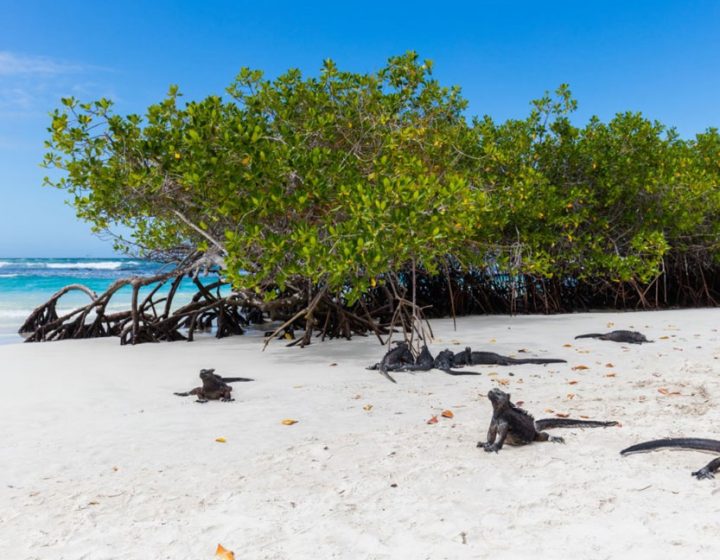12 Days / 11 Nights
ITINERARY
DAY 1: BALTRA Arrival at airport – SANTA CRUZ Highlands & Twin Craters
DAY 2: SANTA CRUZ: Charles Darwin Research Station – Tortuga Bay
DAY 3: SANTA CRUZ: morning free – / ISABELA: Speedboat and transfer to the hotel
DAY 4: ISABELA: AM: Sierra Negra Volcano / PM: Concha de Perla & Tintoreras
DAY 5: ISABELA: Speedboat to Puerto Ayora / SANTA CRUZ – PM: Bay tour
DAY 6: SEYMOUR: Day tour to Seymour *
DAY 7: PLAZAS: Day tour to Plazas Island*
DAY 8: BARTOLOME: Day tour to Bartolome*
DAY 9: SANTA CRUZ: Speedboat ans transfer to the hotel SAN CRISTOBAL: Highlands
DAY 10: SAN CRISTOBAL: Bay tour to León Dormido
DAY 11: SAN CRISTOBAL: Lobería & Mann Beach
DAY 12: SAN CRISTOBAL: Transfer out to the airport
Included
- Transfer in/out
- Meals according to the itinerary: B: Breakfast / L: Lunch / BL: Box Lunch.
- Accommodation in hotels *** (Tourist class) or similar ones depending on availability.
- Visit of the islands according to the program description.
- English speaking Naturalist Guide.
Not Included
- Galápagos Air tickets
- Entrance fee Galápagos National Park USD 100.
- Transit Card USD 20.
- Isabela Entrance Fee USD 10 per person.
- Beverages and extra meals.
- Tips.
- Extras.
Day 1
Flight to Baltra airport. Your guide will take you to explore the natural habitat of the giant Galapagos turtles in the highlands of Santa Cruz Island. On the way to the highlands the vegetation changes considerably and turns humid and green. You will visit Primicias Ranch, a reserve for turtles where you will observe the animals in their natural habitat and also have a beautiful view over the island. In the volcanic formation of the highlands you will also discover ancient lava tunnels and the Twin Craters. Lunch and transfer to the hotel in Puerto Ayora. Overnight
Day 2
In the morning, visit of the Charles Darwin Research Station, which gives you information about the evolution of the islands and hosts a breeding center of giant turtles. You can see different generations of turtles. In the afternoon you will visit Tortuga Bay, one of the most beautiful beaches of Galapagos where marine iguanas, pelicans and sea lions can be observed. After a small walk through a forest of Opuntia cactus you can take a refreshing bath in the ocean. Overnight.
Day 3
Free morning to enjoy this Island on your own. In the afternoon you will take a speedboat to Isabela Island. You will arrive to Puerto Villamil, capital of the island. This is the biggest island of the Archipelago of the Galapagos having 60% of land of all the islands territory. This island is formed by the volcanoes Cerro Azul, Sierra Negra (Santa Tomás), Alcedo, Darwin, Wolf and Ecuador. All of these volcanoes are active, only the old volcano Ecuador is not. Transfer to the hotel. Overnight
Day 4
After the early breakfast you will start a full day tour to the Sierra Negra volcano, with the second largest crater of the world, located at just 13 miles from Puerto Villamil, from where you can enjoy the spectacular view over the beautiful landscape. Lunch at a typical farm, called Hacienda Campo Duro, where you can also taste some local fruit cultivation. In the afternoon you can explore one of the most beautiful beaches of Galapagos called Concha y Perla and you will also do a bay tour to “Tintoreras” which is a group of small islands just in front of Puerto Villamil. Here you can see sea lions, penguins and many fishes in the shallow sea. There is also a small channel where you can observe sharks. Just relax or discover the underwater world while snorkeling in the turquoise sea. Return to the hotel. Overnight
Day 5
In the early morning a speed boat will take you back to Puerto Ayora on Santa Cruz Island. After the arrival you will be taken to the hotel. Later, lunch and bay tour that includes the visit of several places on the coast of Santa Cruz, such as La Lobería, Playa de los Perros, Canal del Amor and Punta Estrada. During this trip you have the opportunity to do snorkeling. Return to the hotel. Overnight
Day 6
North of Baltra is the small islet of North Seymour. The two islands are very similar in appearance both created from geological uplift and having typical arid vegetation including prickly pear cactus, palosantos trees and salt bushes. The visitor trail on North Seymour is approximately (2 km) in length crossing the inland of the island and exploring the rocky coast. Along the way the trail passes colonies of blue-footed boobies and magnificent frigatebirds. The magnificent frigatebird, a large black bird with a long wingspan, and a hooked beak, is extremely fast and has excellent vision. Frigatebirds are known for the large red pouch on their necks. Return to the hotel and overnight.
Day 7
The visit to South Plaza begins with a dry landing. The rocky trail circumnavigates the island displaying the combination of dry and coastal vegetation zone. The island is home to enormous prickly pear cactus and the endemic succulent Sesuvian. These succulents with almond-shaped leaves are green during the rainy season December-May. Then become red during the dry season giving the island an unusual appearance. South Plaza has one of the largest populations of land iguanas in the Galapagos. The iguanas seem to be everywhere once you land. These larger than average yellow-brown land iguanas feed on the fruit and pads of the prickly pear cactus. In the afternoon you have the opportunity to snorkel and swim at Punta Carrion. Return to hotel and overnight at Hotel.
Day 8
Take the speedboat in order to arrive to Bartholome Island. It is a small picturesque island, where you can climb over 300 steps in order to reach the highest point, where a lighthouse is located. From here you are able to admire the different islands of the archipelago and see lava fields. Take the most famous picture of the island, of the Pinnacle Rock. After the walk, go to the beach on the same island, yellow sand and calm bay to snorkel, chances to see: sharks, penguins, sea lions and l
Day 9
After breakfast you will take a speedboat to San Cristobal Island. After 2 hours approximately you will arrive at this incredible island. You will be transferred to the hotel. In the afternoon you are visit La Galapaguera where you can find tortoises, and El Junco lagoon.Overnight.
Day 10
Kicker Rock, (Leon Dormido) is remnant of a vertical tuff formation, abruptly rising almost 500 ft from the ocean. Erosion has split the rock and given it its characteristic shape, which some see as shoe, the origin of the name Kicker Rock. Others see it as a sleeping sea lion or Leon Dormido in spanish. Small vessels pass through the rock which is divided in two parts forming a channel between them. A panga ride around this tuff cone formation gives you the opportunity to see Nascar boobies, blue-footed boobies, and frigatebirds along the cliffs. Located about an hour and half to the northeast of Puerto Baquerizo Moreno. Return to the hotel.
Day 11
Today you are going to know La Loberia, which name is considered because of the colony of sea lions living there. Here you can find also interesting flora incluing button mangrove, white mangrove, chala, palo santo, cotton, Tiquilia, morning glory and other species of the littoral zone as the cacho de chivo, whose seeds is the main source of food for several species of finches. Later enjoy a white sand beach called Playa Mann. You have free afternoon to spend the rest of the day. Overnight
Day 12
In the morning you will be transferred to the airport in order to take the flight to main land. END OF SERVICES






